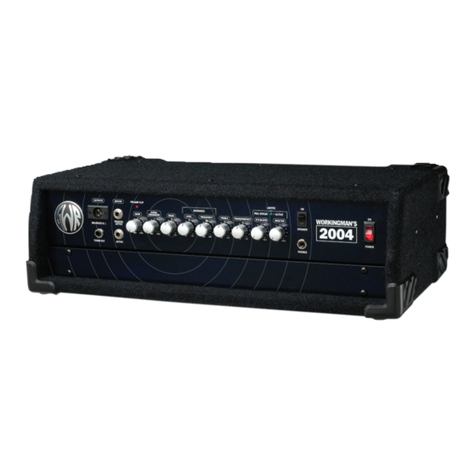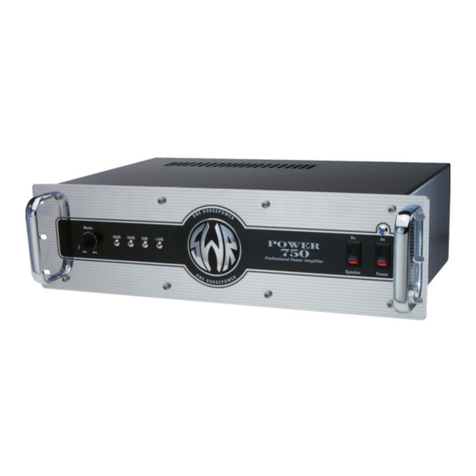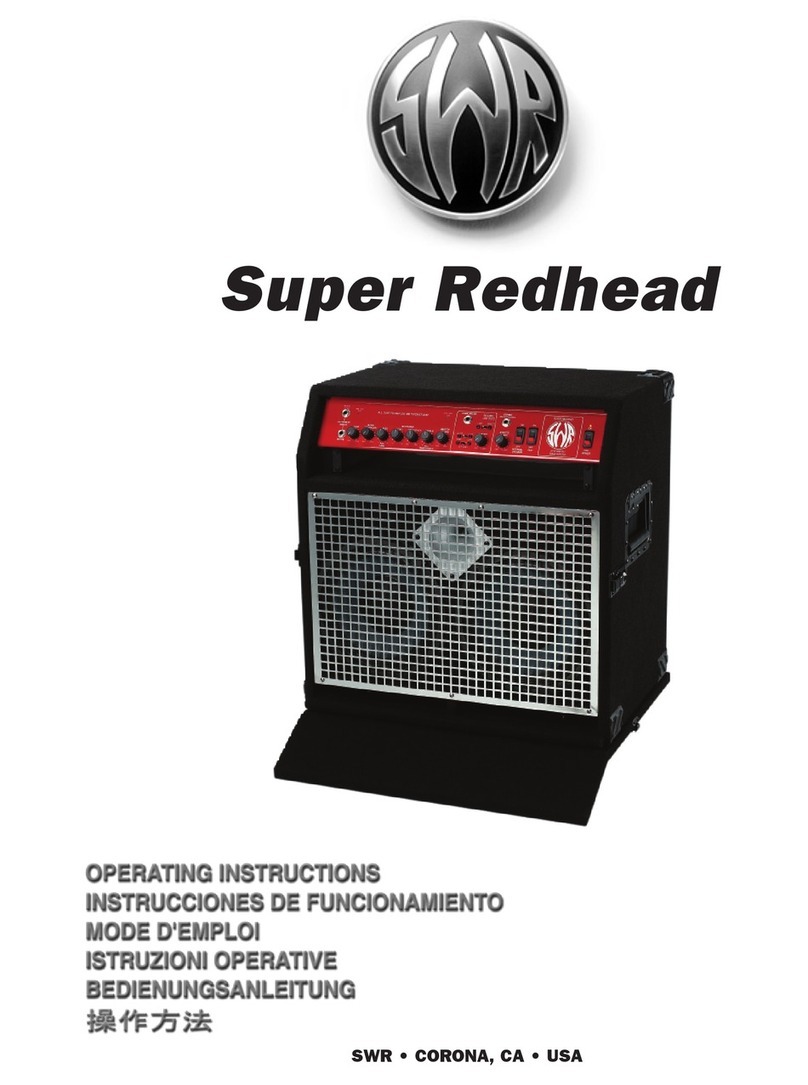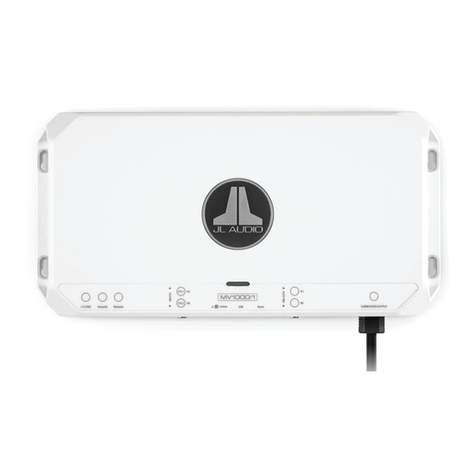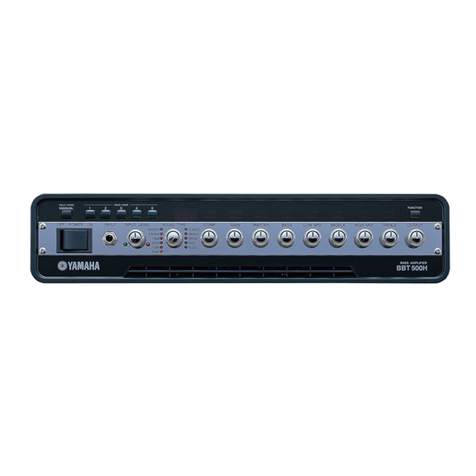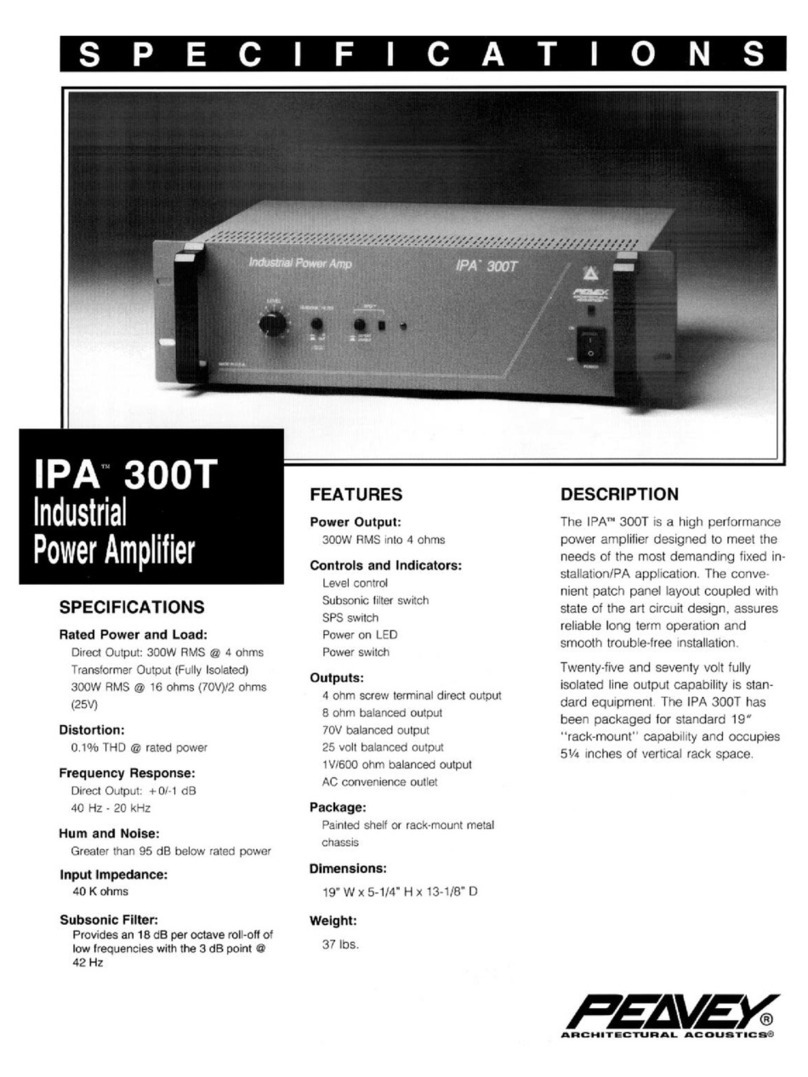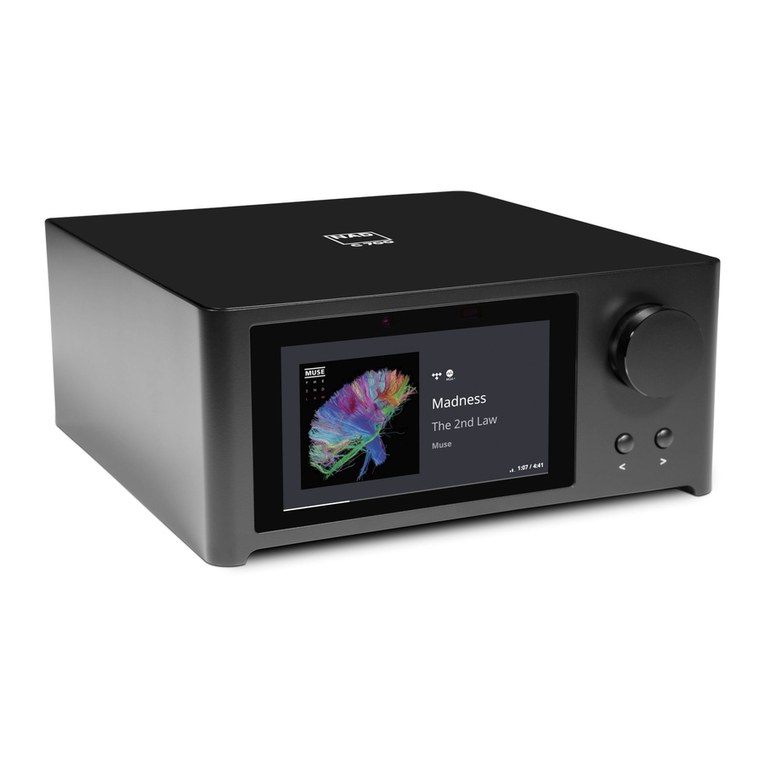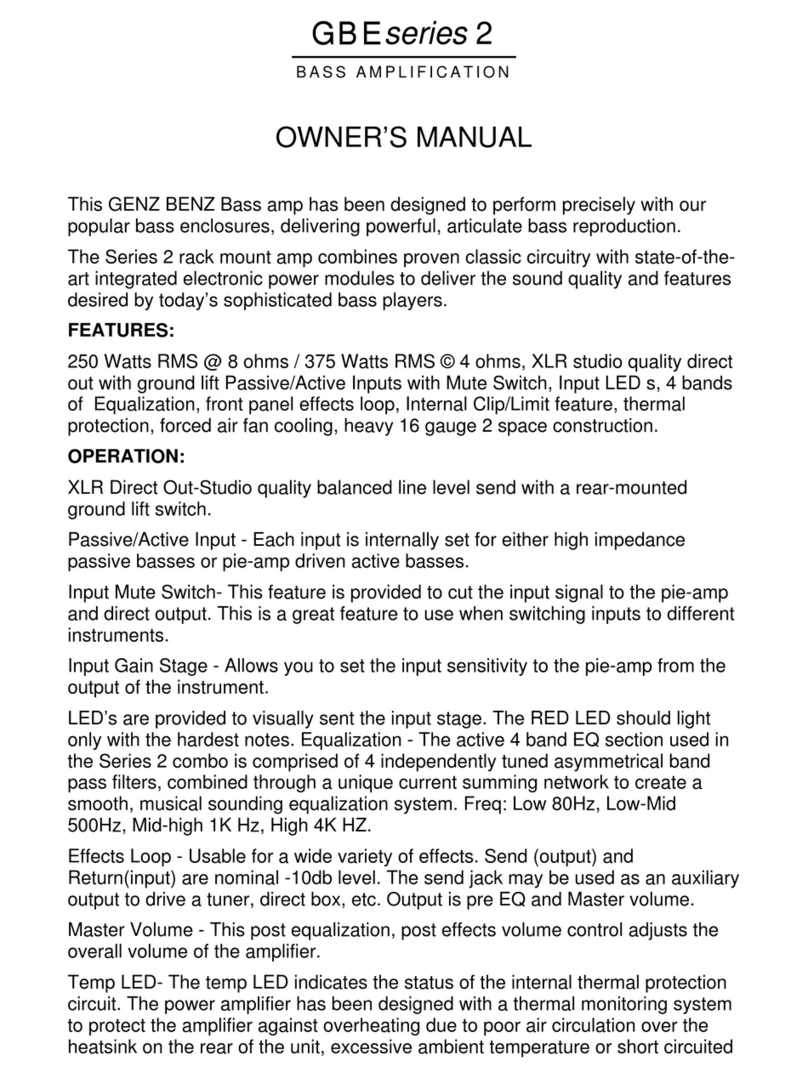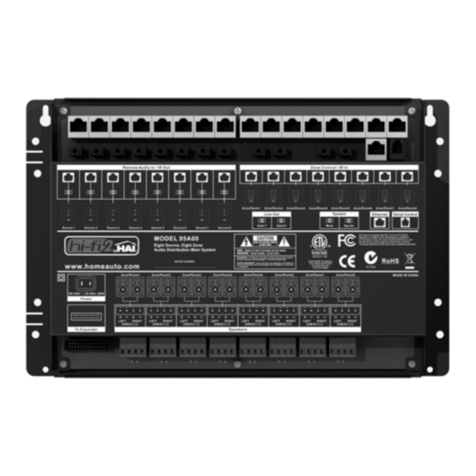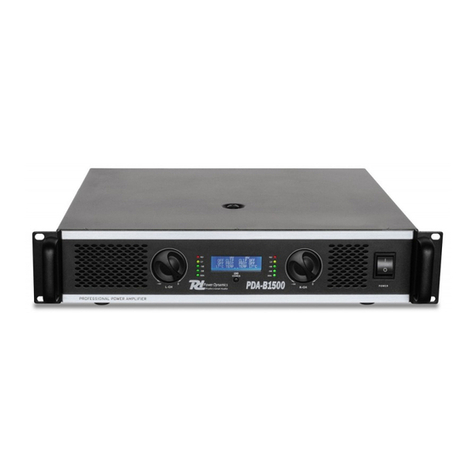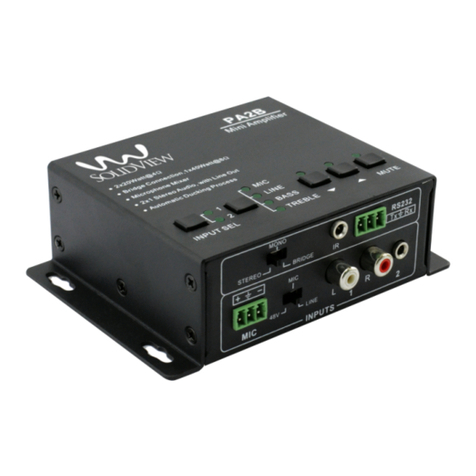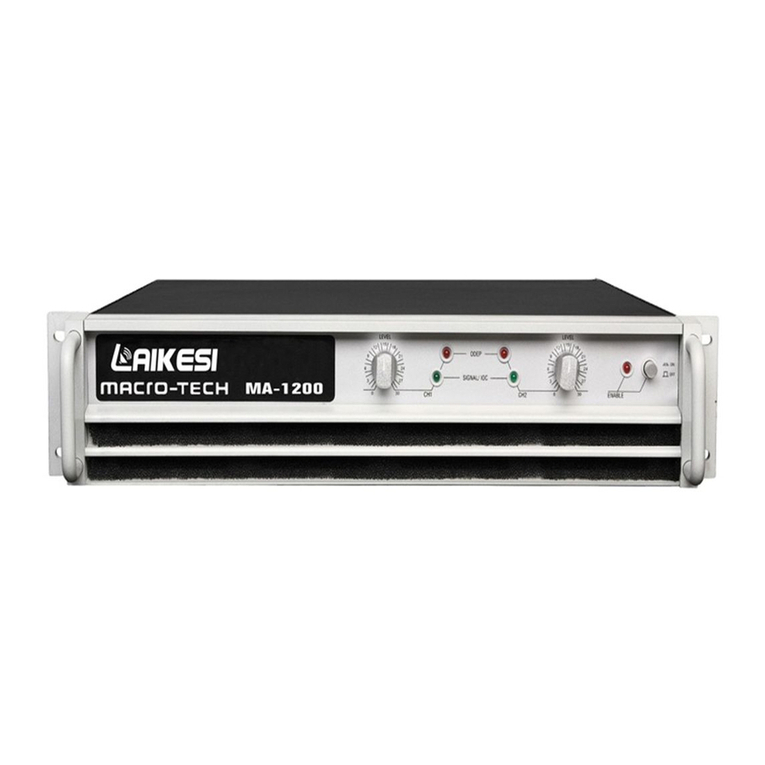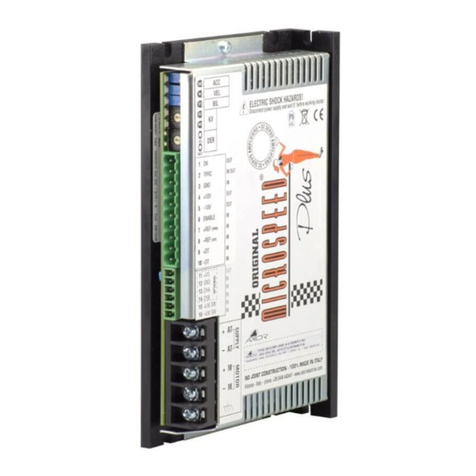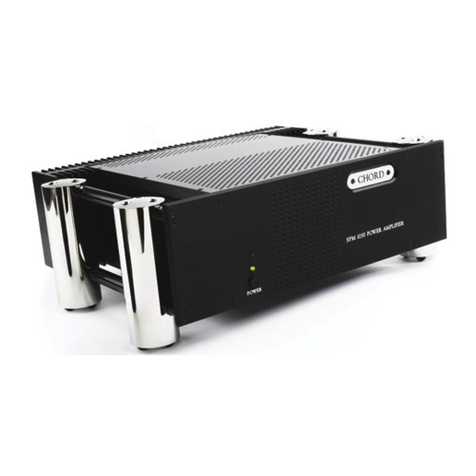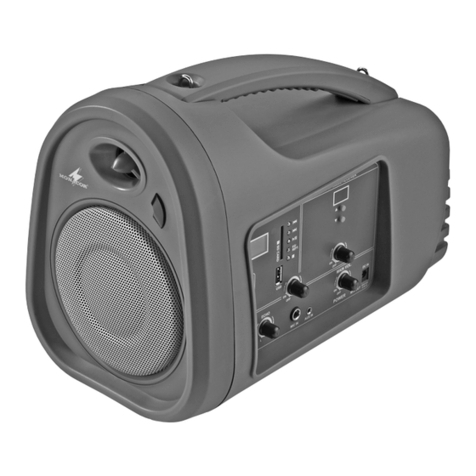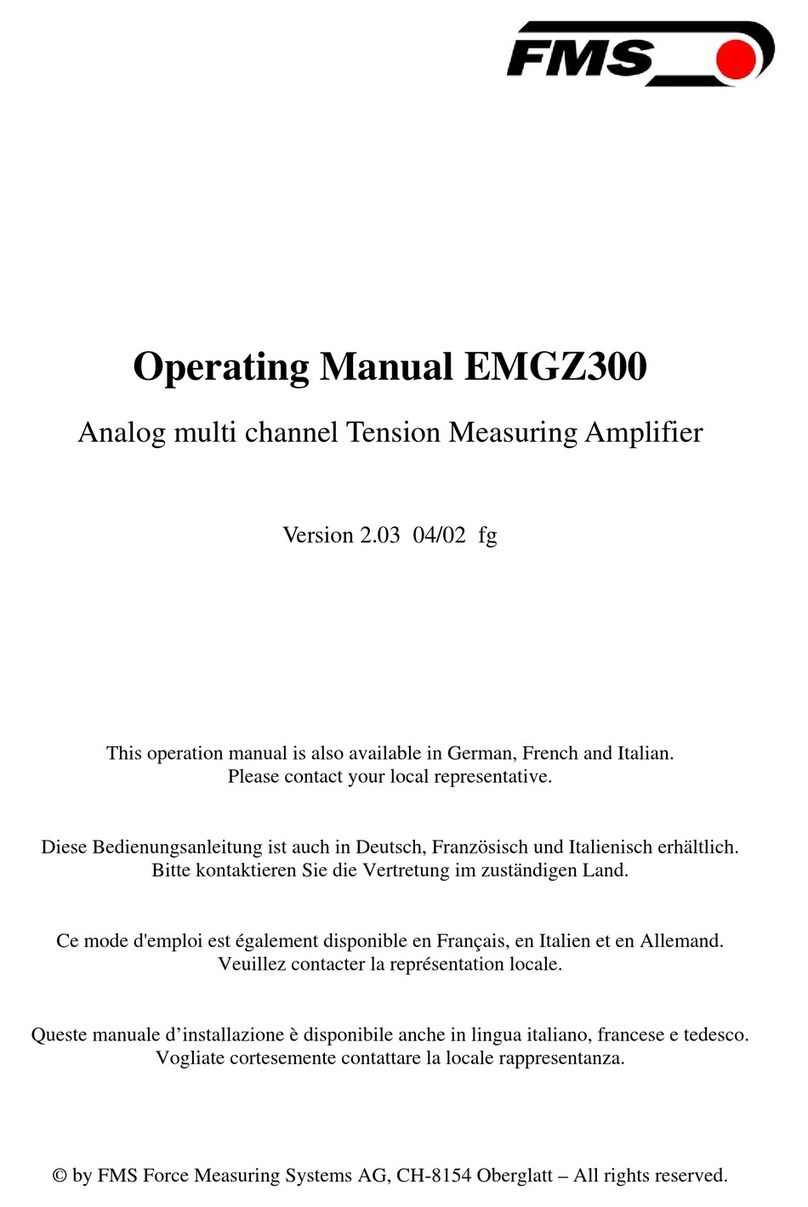SWR 750x Bass Amplifier 750x User manual

750x
SWR • CORONA, CA • USA

ENGLISH - PAGES 6-23
ESPANOL - PAGINAS 24-40
FRANÇAIS - PAGES 41-58
DEUTSCH - SEITEN 59-75
ITALIANO - PAGINE 76-91
92-106

Important Safety Instructions
This symbol warns the user of dangerous voltage levels
localized within the enclosure.
This symbol advises the user to read all accompanying
literature for safe operation of the unit.
∆Read, retain, and follow all instructions. Heed all warnings.
∆Only connect the power supply cord to an earth grounded AC
receptacle in accordance with the voltage and frequency ratings
listed under INPUT POWER on the rear panel of this product.
∆WARNING: To prevent damage, fire or shock hazard, do not
expose this unit to rain or moisture.
∆Unplug the power supply cord before cleaning the unit exterior
(use a damp cloth only). Wait until the unit is completely dry
before reconnecting it to power.
∆Maintain at least 6 inches (15.25 cm)of unobstructed air space
behind the unit to allow for proper ventilation and cooling of the
unit.
∆This product should be located away from heat sources such as
radiators, heat registers, or other products that produce heat.
∆This product may be equipped with a polarized plug (one blade
wider than the other). This is a safety feature. If you are unable
to insert the plug into the outlet, contact an electrician to replace
your obsolete outlet. Do not defeat the safety purpose of this
plug.
∆Protect the power supply cord from being pinched or abraded.
∆This product should only be used with a cart or stand that is
recommended by the manufacturer.
∆The power supply cord of this product should be unplugged from
the outlet when left unused for a long period of time, or during
electrical storms.
∆This product should be serviced by qualified service personnel
when: the power supply cord or the plug has been damaged; or
objects have fallen, or liquid has been spilled onto the product;
or the product has been exposed to rain; or the product does not
appear to operate normally or exhibits a marked change in
performance; or the product has been dropped, or the enclosure
damaged.
∆Do not drip nor splash liquids, nor place liquid filled containers on
the unit.
∆CAUTION: No user serviceable parts inside, refer servicing to
qualified personnel only.
∆SWR amplifiers and loudspeaker systems are capable of
producing very high sound pressure levels which may cause
temporary or permanent hearing damage. Use care when
setting and adjusting volume levels during use.
∆Hazardous voltages may be present within the cabinet even when
the power switch is off and the power cord is connected. Therefore,
disconnect the power cord from the rear panel power inlet before
servicing. The power inlet must remain readily operable.
Instrucciones de Seguridad Importantes
Este símbolo advierte al usuario que en el interior de la
carcasa hay niveles peligrosos de voltaje.
Este símbolo advierte al usuario que lea toda la
documentación adjunta para utilizar la unidad con
seguridad.
∆Lea las atentamente instrucciones y sígalas al pie de la letra.
Tenga en cuenta todas las instrucciones.
∆Conecte únicamente el cable de alimentación eléctrica a una
toma de CA de acuerdo con las especificaciones de voltaje y
frecuencia que se indican en la potencia de entrada INPUT
POWER del panel posterior de este producto.
∆ADVERTENCIA: Para evitar daños, incendios y descargas
eléctricas, no exponga esta unidad a la lluvia ni a la humedad.
∆Antes de limpiar el exterior de la unidad, desconecte el cable de
alimentación (utilícese únicamente un paño húmedo). Deje que
la unidad se seque completamente antes de volver a conectarla
a la corriente.
∆Para una ventilación y refrigeración adecuadas, deje un espacio
mínimo de 15.25 cm detrás de la unidad.
∆Este producto deberá estar situado lejos de fuentes de calor
tales como radiadores, registros de calefacción u otros
productos que generen calor.
∆Es posible que este producto esté equipado con un enchufe
polarizado (un blade más ancho que el otro). Esta es una
función de seguridad. Si no puede introducir el enchufe dentro
de la toma de corriente, póngase en contacto con un electricista
para que la cambie ya que podría estar anticuada. No anule el
propósito de seguridad de este enchufe.
∆Tenga cuidado de que el cable de alimentación no se pinche ni
se erosione.
∆Este producto sólo se debe utilizar con el soporte recomendado
por el fabricante.
∆El cable de alimentación de este producto deberá estar
desconectado de la toma de corriente cuando no se vaya a
utilizar durante un período de tiempo largo o en caso de
tormenta eléctrica.
∆Este producto deberá ser reparado por personal cualificado si:
el cable de alimentación o el enchufe están dañados, ha caído
algún objeto o se ha derramado líquido encima, el producto ha
estado expuesto a la lluvia, no funciona normalmente o muestra
signos de cambio en el rendimiento, ha sufrido algún golpe o la
caja esta dañada.
∆Evite que goteen o salpiquen líquidos y no coloque recipientes
con líquidos sobre la unidad.
∆PRECAUCIÓN: Contiene piezas cuyo mantenimiento no lo
puede realizar el usuario, sino sólo personal cualificado.
∆Los amplificadores y altavoces SWR pueden producir niveles de
presión acústica muy elevados, que pueden provocar daños
temporales o permanenetes en el oído. Utilice la precaución al
ajustar el volumen nivela.
∆Es posible que haya cargas eléctricas peligrosas dentro de la
caja, aunque se haya apagado, mientras esté conectado el cable
de alimentación. Por tanto, se debe desconectar el cable de
alimentación del panel posterior antes de proceder a su
reparación o mantenimiento. La toma de corriente debe
permanecer preparada para su funcionamiento.

Importanti Istruzioni per la Sicurezza
Questo simbolo indica che si avvisa l'utente della
presenza di livelli di tensione pericolosi all'interno della
struttura.
Questo simbolo indica che si consiglia all'utente di
leggere tutta la documentazione allegata ai fini del
funzionamento sicuro dell'unità.
∆Leggere, conservare e seguire le istruzioni. Osservare le
avvertenze.
∆Collegare il cavo di alimentazione solo a una presa c.a. con
messa a terra conforme ai requisiti di tensione e frequenza
indicati sull'etichetta INPUT POWER del pannello posteriore di
questo prodotto.
∆AVVERTIMENTO: Per evitare danni, rischi di incendi o scosse
elettriche, non esporre questa unità alla pioggia o all'umidità.
∆Scollegare il cavo di alimentazione prima di pulire l'esterno
dell'unità (usare solo un panno umido). Attendere che l'unità sia
completamente asciutta prima di ricollegarla all'alimentazione.
∆Lasciare almeno 15.25 cm di spazio libero dietro all'unità per
consentirne il corretto raffreddamento tramite ventilazione.
∆Questo prodotto va collocato lontano da fonti di calore come
radiatori, unità di riscaldamento o altri prodotti che producono
calore.
∆Questo prodotto può essere dotato di spina polarizzata (con poli
grandi). Si tratta di una misura di sicurezza. Se non si riesce a
inserire la spina nella presa, far sostituire la presa obsoleta ad
un elettricista. Non eliminare la spina di sicurezza.
∆Proteggere il cavo di alimentazione da danni e abrasioni.
∆Questo prodotto deve essere usato solo con un carrello o con un
supporto consigliato dal produttore.
∆Il cavo di alimentazione di questo prodotto deve essere
scollegato dalla presa quando il prodotto non viene usato per
lunghi periodi o durante le tempeste elettromagnetiche.
∆La manutenzione per il prodotto deve essere eseguita da
personale di assistenza qualificato nei casi seguenti: danno del
cavo o della spina di alimentazione; caduta di oggetti o di liquido
sul prodotto; esposizione del prodotto alla pioggia;
funzionamento anomalo del prodotto o marcata variazione delle
prestazioni del prodotto; caduta del prodotto; danno della
struttura del prodotto.
∆Non disporre alcun contenitore riempito di liquido sul prodotto.
∆ATTENZIONE: Non contiene parti riparabili dall'utente: fare
eseguire la manutenzione soltanto da personale qualificato.
∆I sistemi di amplificazione e gli altiparlanti SWR sono in grado di
produrre livelli di pressione acustica molto alti che possono
provocare danni temporanei o permanenti all'udito. Prestare
attenzione all'impostazione e regolazione dei livelli di volume
durante l'uso.
∆All'interno dell'apparecchiatura possono essere presenti livelli di
tensione pericolosi anche quando l'interruttore dell'alimentazione
è disinserito ma il cavo di alimentazione è collegato. Si
raccomanda, perciò, di staccare tale cavo dalla presa
dell'alimentazione posta sul pannello posteriore prima di
eseguire qualsiasi intervento di manutenzione. La presa
dell'alimentazione deve, tuttavia, rimanere sgombra e pronta per
l'uso in qualunque momento.
Consignes de Sécurité Importantes
Ce symbole avertit l'utilisateur de la présence de
niveaux de tension à risque dans l'appareil.
Ce symbole conseille à l'utilisateur de lire toute la
documentation jointe au produit pour garantir une
sécurité de fonctionnement.
∆Veuillez lire attentivement toutes les instructions et vous y
conformer. Respectez scrupuleusement tous les avertissements.
∆Connectez le câble d'alimentation électrique à une prise CA mise
à la terre selon le voltage et la fréquence indiqués sur le panneau
arrière de l'amplificateur sous INPUT POWER.
∆AVERTISSEMENT: Pour éviter l’endommagement de l’appareil,
un départ d’incendie, ou un choc électrique, ne l’exposez jamais
a l’humidité ou à la pluie.
∆Débranchez le câble d'alimentation avant de nettoyer le boîtier de
l'appareil (utiliser un chiffon légèrement humide). Attendez que
l'appareil soit complètement sec avant de le rebrancher sur le secteur.
∆Conservez au moins 15.25 cm d'espace derrière l'appareil pour
permettre une aération appropriée de celui-ci.
∆Il est conseillé d'entreposer cet appareil loin de toute source de
chaleur, telle que des radiateurs, des accumulateurs de chaleur
ou autres unités produisant de la chaleur.
∆Cet appareil peut être équipé d'une prise polarisée (une fiche plus
large que l'autre). C'est une garantie de sécurité. Si vous ne
parvenez pas à insérer la prise dans la sortie, contactez un
électricien pour qu'il remplace la sortie. Ne modifiez rien qui
puisse supprimer les garanties de sécurité qu'offre cette prise.
∆Veillez à ce que le câble d'alimentation ne soit pas coincé ou
abrasé.
∆Cet appareil doit uniquement être utilisé avec un support à
roulettes ou un pied conseillé par le fabricant.
∆Le câble d'alimentation de cet appareil doit être débranché de la
sortie lorsqu'il reste longtemps sans être utilisé ou en cas d'orage
électrique.
∆Les réparations et la maintenance de cet appareil doivent être
effectuées par un personnel qualifié dans les cas suivants : le
câble d'alimentation ou la prise sont endommagés ; des objets
sont tombés sur l'appareil, du liquide a été renversé dessus ou
l'appareil a été exposé à la pluie ; l'appareil ne semble pas
fonctionner normalement ou vous notez des changements
notables dans la performance de l'amplificateur, ou encore le
produit est tombé ou l'enceinte est endommagée.
∆Ne placez aucun récipient rempli de liquide sur le produit.
∆ATTENTION: Aucune maintenance ne doit être effectuée pour
les pièces situées dans l’appareil. Les réparations et la
maintenance doivent être exécutées uniquement par une
personne qualifiée.
∆Les niveaux sonores élévés émis par les systèmes d'emplificateur
et haut-parleurs SWR peuvent entraîner des lésions auditives
durables. Faites attention lorsque vous réglez ou ajustez le
volume lors de l'utilisation des appareils.
∆Voltage dangereux. Risque d'électrocution au niveau du coffret
lorsque le câble d'alimentation est branché même si l'appareil
n'est pas sous tension. Débranchez le câble d'alimentation du
panneau arrière avant de travailler sur l'appareil. L'entrée
électrique doit rester accessible.

Wichtige Sicherheitshinweise
Dieses Symbol warnt den Benutzer vor gefährlichen
Spannungen innerhalb des Gehäuses.
Dieses Symbol bedeutet für den Benutzer, dass er für
einen sicheren Betrieb des Geräts die gesamte
begleitende Dokumentation lesen muss.
∆Befolgen Sie sämtliche Sicherheitshinweise und bewahren Sie
sie auf. Beachten Sie alle Warnungen.
∆Das Netzkabel muss an eine geerdete Netzsteckdose
angeschlossen werden, die die auf der Rückseite des
Verstärkers unter INPUT POWER angegebene Spannung und
Frequenz liefert.
∆WARNUNG: Setzen Sie dieses Gerät niemals Regen oder
Feuchtigkeit aus, um Beschädigung, Brandentwicklung und
elektrische Schläge zu vermeiden.
∆Ziehen Sie den Netzstecker, bevor Sie das Gehäuse des Geräts
reinigen (verwenden Sie zum Reinigen nur ein feuchtes Tuch).
Stecken Sie den Netzstecker erst wieder ein, wenn das Gerät
vollständig getrocknet ist.
∆Halten Sie hinter dem Gerät einen Freiraum von mindestens 15.25
cm ein, damit eine ausreichende Belüftung gewährleistet ist.
∆Der Verstärker darf nicht in der Nähe von Wärmequellen wie
Heizkörpern oder anderen wärmeerzeugenden Geräten
aufgestellt werden.
∆Dieses Produkt ist möglicherweise mit einem unvertauschbaren
Stecker ausgestattet (unterschiedlich breite Pole). Dabei
handelt es sich um eine Sicherheitsvorrichtung. Wenn Sie den
Stecker nicht in die Steckdose stecken können, lassen Sie Ihre
alte Steckdose von einem Elektriker auswechseln. Zerstören Sie
nicht die Sicherheitsfunktion des Steckers.
∆Das Netzkabel darf nicht eingeklemmt oder abgescheuert werden.
∆Das Produkt sollte nur mit vom Hersteller empfohlenen Karren
oder Ständern verwendet werden.
∆Bei Gewitter oder wenn das Gerät längere Zeit nicht gebraucht
wird, sollte der Netzstecker gezogen werden.
∆In folgenden Fällen sollte das Gerät repariert werden, und zwar
ausschließlich von qualifizierten Technikern: Schäden an
Netzkabel oder -stecker; Beschädigung durch herabfallende
Gegenstände, ausgelaufene Flüssigkeit oder Regen;
Funktionsstörungen oder deutlich verändertes
Betriebsverhalten; Beschädigung durch Herunterfallen; Schäden
am Gehäuse.
∆Setzen Sie das Gerät keiner tropfenden oder spritzenden
Flüssigkeit aus; stellen Sie keine mit Flüssigkeit gefüllten
Behälter auf dem Gerät ab.
∆VORSICHT: Im Gerät sind keine zu wartenden Teile.
Reparaturarbeiten dürfen nur von qualifizierten Technikern
durchgeführt werden.
∆SWR-Verstärker und Lautsprecher können sehr hohe
Lautstärkepegel erzeugen, die vorübergehende oder dauerhafte
Gehörschäden verursachen können. Gehen Sie beim Einstellen
bzw. Regulieren der Lautstärke vorsichtig vor.
∆Im Gehäuse können auch im ausgeschalteten Zustand
gefährliche Spannungen auftreten, wenn das Netzkabel
eingesteckt ist. Ziehen Sie daher das Netzkabel aus der
Netzanschlussbuchse auf der Rückseite des Geräts bevor Sie
Wartungs- oder Reparaturarbeiten vornehmen. Die
Netzanschlussbuchse muss stets frei zugänglich bleiben.
∆
∆
∆
∆
∆
∆
∆
∆
∆
∆
∆
∆
∆
∆
∆

6 • 750x
INTRODUCTION
Congratulations on your purchase of the SWR 750x Bass Amplifier! You now own a killer combination of
massive power, easy-to-use controls, simply integrated onboard effects… and pure SWR tone.
A little history: The SWR 750x is an upgraded version of the Bass 750, a model we’ve offered since 1999
in response to demand for an amp that delivered the punch and volume of classic high-powered amplifiers,
coupled with the sound and clarity SWR is known for. The highest-powered mono head in our world-renowned
Professional Line, the Bass 750 featured a tube preamp (using a specially-selected 12AX7A vacuum tube),
SWR’s patented “Aural Enhancer,” an easy-to-use 3-band EQ section, and a high-quality, discrete solid-state
750-watt power amp capable of delivering enough power and headroom for just about any application. Highly
popular among rock, funk and jazz players alike, the Bass 750 quickly became a staple on large stages in
high-profile venues, as well as in local clubs where bassists quickly saw the benefits of having more than
enough power to do the job.
The new 750x maintains all of these proven features while adding significant improvements. We’ve integrat-
ed two new onboard effects. First, the Tube Overdrive provides the option of having a high-powered “dirty”
amplifier at the ready, all the while preserving the famous SWR clean tone—and without having to lug
around an 80-pound all-tube amplifier. Second, there’s our SubWave™ circuit, which produces a tone an
octave below the original signal and tracks as well or better than anything else on the market today. (The
effects are foot-switchable, and we’ve provided a dual footswitch for your convenience.) Additionally, the unit
is now lighter, quieter (in terms of overall residual and white noise), and in our humble opinion, better-look-
ing thanks to a cosmetic rework from the ground up. And, of course, each 750x is assembled by hand and
individually sound-tested in the USA at our factory in Southern California.
It’s all part of SWR’s commitment to continued improvement and refinement of even our most popular mod-
els, so that we can continue to assist today’s bassist in the pursuit of the ultimate goal: finding equipment
that not only does the job, but actually enhances the overall musical experience and contributes to the cre-
ative process. Everyone here at SWR sincerely hopes that the purchase of your 750x helps you get there
from here… and beyond.
Please take the time to read your Owner’s Manual thoroughly and completely, so that you can realize the full
potential of your new 750x Bass Amplifier. Once again, thanks for your purchase, and for letting SWR help
Amplify Your Future.™
Sincerely,
SWR
Note: Please take a moment to verify that the following items were included in your SWR 750x
packaging: AC Cable, 750x Effects Activator Dual Footswitch.

750x • 7
750x – FRONT PANEL FEATURES
• Dual independent input jacks compatible with both passive and active instruments
• Preamp Gain control with red LED clip indicator
• Aural Enhancer control
• Overdrive Activator Switch (illuminated red when engaged)
• Overdrive “Drive” Control
• Overdrive Level Control
• SubWave™ Activator Switch (illuminated blue when engaged)
• SubWave™ Level control
• Bass control (with Pull Turbo function)
• Midrange Level control
• Midrange Frequency control
• Treble control (with Pull Transparency function)
• Effects Blend control
• Variable Limiter
• Limiter Active green LED indicator
• Master Volume control
• Speaker On/Off Switch
• Illuminated Neon Power On/Off switch
750x – REAR PANEL FEATURES
• XLR Pad (Level) control
• XLR Output jack
• XLR Mode switch (Direct, Direct + EFX, Line)
• Ground/Lift switch for XLR Output jack
• Side-Chain Effects Loop (Effects Send and Effects Return 1/4" jacks)
• Tuner Out Jack
• Preamp Out Jack
• Overdrive Activator Footswitch jack
• SubWave™ Activator Footswitch jack
• Fan Mode switch
• Stereo Headphones Jack
• Two Speakon and two 1/4" Speaker Output jacks
• Speaker Fuse (3AG, 10-amp fast-blo)
• Line Fuse
• AC Power Cord Receptacle
ELECTRICAL SPECIFICATIONS
Note: All measurements were taken with a line voltage of 120VAC. All noise specifications are
“unweighted.” All voltages and watts are “RMS.” All measurements are taken with tone controls
set flat, Aural Enhancer at minimum.
Power Ratings (minimum)
750 Watts @ 4 ohms
450 Watts @ 8 ohms

8 • 750x
Frequency Response (power amplifier)
(@ 750 watts RMS) –3dB @ 20 Hz and 40 kHz
Sensitivity (full output under clipping, 8 ohms load, 100 Hz)
Passive Input Jack: 62 millivolts
Active Input Jack: 267 millivolts
Power Amplifier (Effects Return Jack “in”): 5 volts
Input Impedance
Passive/Active Input: 800k Ohms
Active Input: 60k Ohms
Effects Return: 27k Ohms
Output Impedance
Effects Send: 100 Ohms
Tuner Send: 100 Ohms
XLR (Balanced) Out: 750 Ohms
Dimensions (depth includes handles and XLR pad)
19" W x 5.38" H x 15" D (3 rack spaces)
Weight
31 lbs.
750x – GETTING STARTED
Connecting Your Speaker Cabinets
The 750x is a mono amplifier, which makes things fairly simple. Locate the “Speaker Outputs” section on
the rear of the amp. You will notice that there are four different speaker output jacks, two 1/4" type and
two Speakon®type jacks. The Speakon jacks are preferable if your speaker cabinet is equipped with
Speakons as well; however, you can use any of the four available jacks to connect your speaker(s) to the
750x.
Using One Speaker Cabinet
Using a speaker cable of 18 gauge or heavier (the heavier the cable, the lower the gauge), simply connect
any one of the 750x’s Speaker Output jacks to the input jacks of your speaker cabinet. If your cabinet is a 4
ohm enclosure, the 750x will deliver will deliver 750 watts into it. If your cabinet is an 8 ohm enclosure, it
will deliver 450 watts into it. This is a loud amplifier. Be sure to check the power handling capabilities of
your speaker cabinet before connection and operation.
Using Two Speaker Cabinets
Using a speaker cable of 18 gauge or heavier (the heavier the cable, the lower the gauge), simply connect
any of the 750x’s Speaker Output jacks to the input jacks of your two speaker cabinets. (You can use one
1/4" and one Speakon Output jack each if you wish; however, it is always best to use speaker cables with
similar type ends.) If the cabinets are the same impedance, the same amount of power will be sent to each
enclosure. If the cabinets are different impedances, more power will flow to the cabinet with the lower
impedance. Since the 750x is a mono amplifier and individual cabinet levels cannot be adjusted, it is rec-
ommended that you use cabinets of the same impedance when using more than one cabinet. If you use two
8 ohm cabinets—the two-cabinet setup recommended by SWR—the resulting “total” impedance will be 4
ohms, and the 750x will deliver 750 watts spread across both cabinets. Needless to say, in all cases, be
sure to check the power handling capabilities and impedance of your speaker cabinet(s) before connection
and operation.

750x • 9
Important: The minimum total impedance when operating the 750x is 4 ohms. This means you can safely
use:
a) A single 8 ohm cabinet
b) A single 4 ohm cabinet
c) Two 8 ohm cabinets (total: 4 ohms)
Turning The Unit On
Remove the AC cable from the accessory pack and connect it from the amplifier to a standard wall outlet.
Make sure that the both the Gain and Master Volume controls are set to the minimum position. Locate the
Power switch on the right side of the front panel and turn the amplifier on. The Power switch should then illu-
minate in red. Upon powering up, don’t be surprised if you hear a small pop. This is absolutely normal.
(Eliminating this “power on transient” would require a component called a relay. SWR chose not to incorpo-
rate this type of component due to the fact that relays degrade signal quality and often fail, causing the unit
to have no output and requiring a trip to a local service center. The noise can be eliminated by setting the
speaker on/off switch to the “off” position upon powering up, after which point you can set the switch to
“on” for operation.)
Getting Sound Out Of The 750x
Plug your instrument into the desired input jack (please refer to “Front Panel Features” for more detail). Turn
your instrument’s volume up to at least 75% of maximum and slowly adjust up the Gain control. Keep play-
ing and turning the Gain control up until you see the Preamp Clip LED turn red. Then back off the Gain
Control about one large hash mark on the dial. Now turn up the Master Volume control to an equal level.
You should now hear the sound of your instrument amplified through the 750x into your speaker cabinet(s).
Eventually you may want to reset the Gain Control in conjunction with your desired settings for the Overdrive
effect, but we’ll get to that later on in the manual.
750x – FRONT PANEL FEATURES
Input Jacks
Both input jacks accept a standard 1/4" phone plug and both inputs can be used at the same time. Since
the two inputs are totally independent, no loss in volume or tone will occur by using two instruments simul-
taneously. However, the main applicational use for the two separate input jacks is their difference in level,
as the Passive/Active input has five times more gain than the Active input. In other words, it’s not necessar-
ily intended as a “submixer” for two instruments, but no harm will come from having two instruments
plugged in at once. Please read below for more details.
Passive/Active Input Jack
This input jack is designed to accommodate both “passive” instruments and most “active” instruments. A
passive instrument has no built-in preamp and does not use a battery, while an active bass utilizes a bat-
tery-operated preamp for gain, tone controls, or both. The Passive/Active Input will work with all instruments
having a maximum output of less than 1 volt RMS. Some active pickups such as EMG, Bartolini, etc., use
batteries for operation and will work perfectly using this input. Instruments made by MTD, Sadowsky,
Modulus, etc., have active electronics that are suited for use in the Passive/Active input.
Generally speaking, try this input first. If you hear a small amount of distortion and the Preamp Clip LED is
not activated, try using the Active input jack. If the Active input does not correct any audible distortion,
check the battery in your bass.
Note: If you would like to overdrive the first TUBE stage, this can be accomplished by using an
external preamp between your instrument and the Passive/Active input. To obtain optimum sound
when trying this, make sure the Preamp Clip LED is not activated. If this occurs, turn down your
Gain control until the LED does not light. The first preamp tube stage is NOT monitored by the pre-
amp clip circuit for this reason.

10 • 750x
Active Input Jack
The Active input jack should be used with instruments having a built-in (on board) preamp or other sound
sources that will produce output levels greater than 1 volt RMS. The number of bass manufacturers has
increased significantly over the years, and it’s impossible to try and keep track of them all. Generally, if you
have very “hot” pickups and/or tone controls installed in your instrument, and you use them to boost the
level of your bass signal 10 dB or more, you may find the Active input more compatible. The best judge is
your own ears.
If you’re using a keyboard or bass pedal with the 750x, we have found the best choice to be the Active
input.
Note: Using the Active input with passive basses (active instruments will always employ a battery)
may result in a loss of high end transients. Players who roll off their high end starting at about
2kHz, or prefer a “darker” sound, may find this input more to their liking.
If you hear some distortion with your active bass and are using the Active Input, make sure the Preamp Clip
LED indicator is not lighting. If the preamp stage is not being driven into clipping, replace the battery in your
instrument.
Gain Control
The Gain control adjusts the volume of the preamp section. Since the Gain control is similar to a “pad,” a
small amount of signal will be heard even with the Gain control rotated fully counter-clockwise (“MIN”) if the
Master Volume is up.
After all EQ settings and the Aural Enhancer are set, the Gain control should be raised until the Preamp Clip
LED barely flashes when your loudest note is struck. This will insure maximum signal to noise ratio and pre-
vent unwanted clipping of the preamp section.
Note: The Gain can serve as an EFFECTS SEND LEVEL ADJUSTMENT. If your effect is being overdriv-
en, turn down the Gain control and readjust your Master Volume for overall loudness.
Preamp Clip LED
The Preamp Clip LED will light whenever the preamp, tone section or output buffer reach clipping (run out of
headroom). This function does NOT monitor the first tube stage of the Passive input. See that section for
more info.
In the event the clip indicator lights, turn down the Gain control. Since this circuit monitors the tone con-
trols, boosting any one of them can cause the Preamp Clip LED to activate. Once again, you may leave the
tone control at its desired level, but turn the Gain control down further.
Note: Even though the Preamp Clip LED lighting indicates that at some point the preamp is clipping,
no harm is being done to your amplifier. However, clipping of the power amp can cause damage to
your speakers and is not recommended.
Aural Enhancer
The Aural Enhancer is a feature that’s been on just about every SWR amplifier since the company’s incep-
tion in 1984, and is a trademark part of the “SWR Sound” people have come to know and love. It was
developed to help bring out the fundamental low notes of the bass guitar, enhance the high-end transients,
and reduce certain frequencies that help “mask” the fundamentals. The ultimate result is:
1. A more transparent sound, especially noticeable when slapping and popping.
2. It can make a passive bass take on an “active” type of quality when set at positions of “2 o’clock” or
further clockwise.
Let’s take a second to learn how the Aural Enhancer works. Think of it as a variable tone cur ve that
changes depending on where you set the Aural Enhancer control knob. As you raise the control clockwise
from the “MIN” position, you are elevating a whole range of sound (lows, mids, and highs) at a variety of fre-
quency points selected specifically because they’re different than those selected for the individual Tone
Controls.

750x • 11
This remains true up to about the “2 o’clock” position. This position—a favorite for many users—brings out
both the low end fundamentals and crisp highs and, at the same time, adds a little lower midrange to help
cut through the band. However, if you go further clockwise and past the 2:00 position, selected mids will
start to drop off—specifically, a group of frequencies centered around 200 Hz. At this point and after, the
effect becomes much more pronounced. However, the curves involved here are gentle, as opposed to the
very extreme curves you can create by boosting or cutting the Active Tone Controls (EQ).
Most significantly for basses, the Aural Enhancer will help bring out the fundamentals of your lower registers
without masking them with overtones, as is possible when using the Bass control only. At the same time, it
opens up the sibilance characteristics of all instruments without being harsh.
Obviously, numbers and curves and circuits all mean nothing compared to what you hear with your own
ears. Play a chord, a repeated lick, or a harmonic, and turn the Aural Enhancer control to various points on
the knob to hear the effect for yourself. As always, your ears are the best judge when it comes to settings
that affect the tone of your instrument.
Overdrive Controls
Based on the extremely popular circuit from SWR’s groundbreaking Mo’ Bass Soundstation, the Tube
Overdrive onboard your 750x has been carefully calibrated to give you as much (or little) overdriven signal
as necessary, all the while keeping the low end (and ultra-high end) wholly intact through the use of low and
high-pass filters. That’s the technical description. In plain English, it’s just like a second channel on the
front end of your amp. And by using the “Drive” (think: pre) and Level (think: post) controls, you can dial it
in to get just a little bit of “edge” on the note… or, if you prefer, you can turn your tone into a buzzsaw and
cut down trees with it.
Overdrive Activator Switch
Located directly above the Overdrive controls, this is an illuminated push-button switch that activates the
Overdrive effect. When engaged, the switch cap will illuminate in red. Push once to engage, then again to
disengage. (The Overdrive effect can also be switched on and off via footswitch; please see the heading
titled “Effects Activator Footswitch Jacks” in the “Rear Panel Features” section later in this manual.)
Overdrive “Drive” Control
Located on the outer portion of the dual concentric knob underneath the Overdrive Activator Switch, the
Drive Control adjusts the amount of distortion present in the signal. Some people refer to this element of
an overdriven signal as the “pre” or the “gain.” Rotating the control clockwise will increase the distortion
present, while going counter-clockwise will decrease it. To hear what kind of effect this control has on
your sound, engage the Overdrive effect by pushing the Overdrive Activator Switch (at which point the
switch should illuminate in red). Set the Overdrive level (the inner portion of the dual concentric knob) to
the 12:00 position. Now strike a note repeatedly and slowly turn up the Drive control to your liking.
Overdrive Level Control
Located on the inner portion of the dual concentric knob underneath the Overdrive Activator Switch, the
Level Control adjusts the factor by which the signal level is boosted before leaving the Overdrive circuit
and blending back into the clean signal. Some people refer to this element of an overdriven signal as the
“post” or the “master.” Rotating the control clockwise will increase the level of the distorted signal, while
going counter-clockwise will decrease it. It can be used in conjunction with the Drive control to achieve
“unity gain” (no overall level difference) with your clean sound, or to help you achieve as much boost as
you feel is necessary when engaging the effect.
Using The Overdrive Controls
As mentioned previously, the two controls are meant to work together to help get you the kind of overdriv-
en sound you want. For a mellow “fuzz” on the note, or just a touch of drive, set the Drive fairly low and
the Level fairly high. For a drastic tonal change involving heavy distortion while keeping your levels intact
during channel switching, set the Drive high and the Level low to medium (you’ll notice that you need a
certain amount of Level dialed in to make the circuit effective). As always, the best judge is your own
ears.

12 • 750x
Remember, when you’ve got this effect engaged, you’ve essentially converted your 750x into a two-chan-
nel amplifier. The Overdrive acts as “Channel Two,” and you can set it to best suit your needs in combina-
tion with the level of the clean “Channel One.” How do you control the level of “Channel One?” By using
the Gain Control, which controls the level of the clean bass signal in the preamp.
Also, the EQ Controls are located after the Overdrive circuitr y, so they can have a drastic effect on the
distorted tone. (The treble control is especially useful for adding or removing a nasty edge to your
Overdrive sound.) And don’t forget about the Limiter, which, when dialed higher than you might think nec-
essary, is often useful in combination with distorted signals to create warm, smooth overdriven tones.
Finally, if you engage the effect and both the Drive and Level controls are set to minimum, there will be
little or no change in your tone. This is normal.
SubWave™ Controls
Once again, based on the circuit from SWR’s Mo’ Bass, the SubWave™ on your 750x is a lightning-quick
sub-octave wave engine with tracking superior to other models of sub-octave effects currently on the mar-
ket. In plain terms, it hears the note you play and immediately generates a signal one octave below it—all
the way down to low “C#,” “C,” or even low “B” on some basses!
SubWave™ Activator Switch
Located directly above the SubWave™ Level Control, this is an illuminated push-button switch that acti-
vates the SubWave™ effect. When engaged, the switch cap will illuminate in blue. Push once to engage,
then again to disengage. (The SubWave™ effect can also be switched on and off via footswitch; please
see the heading titled “Effects Footswitch” in the “Rear Panel Features” section later in this manual.)
SubWave™ Level Control
Once the SubWave™ effect is engaged, you can use this control to determine the amount of effect to be
blended in with your original (“clean”) bass signal. Turning the control clockwise will increase the amount
of effect, while turning the control counter-clockwise will decrease the amount of effect. When the control
is set fully counter-clockwise to “MIN”, no effect will be heard, even though the effect is engaged and the
Activator switch is illuminated in blue. This is normal. Also, when the control is set fully clockwise to
“MAX”, the “clean” bass signal will still be present…along with plenty of sub-octave effect. As always,
your ears and the desired musical application will be the best judge in setting this control.
(Keep in mind that the Bass Level control will have a significant impact on the perceived level of the
SubWave™ effect as well, as it follows immediately after the SubWave™ in the signal chain. Please read
below.)
Balancing Levels When Using Both Onboard Effects
If you wish to use the Overdrive and Subwave™ effects at the same time, here’s something you should
know. The Gain control effects the level of the Subwave™ effect, but it does not affect the Overdrive. So, if
you’re balancing the overall Overdrive signal against the clean sound, it’s worth remembering that if you
turn the Gain Control down, you’re also reducing the amount of Subwave™ present in the final blended sig-
nal. Basically, when it comes to setting levels for using both effects at once and switching back and forth
between sounds, you have three controls you can adjust: the Gain Control, the Overdrive “Drive” Control,
and the Subwave™ Level Control. Experimentation is encouraged.
750x – ACTIVE TONE CONTROL SECTION
Bass Control
The Bass control employs a shelving-type circuit and boosts or cuts the bass response +/–15dB, from
about 30 Hz to 100 Hz, centered at around 80 Hz. Starting at the control’s mid-position (“center-click”),
turning the control counter-clockwise cuts the bass response, and turning the control clockwise boosts the
bass response.

750x • 13
You’ll find that the Bass Level control will boost or cut the SubWave™ effect along with the “clean” bass
signal; that’s because of the range of frequencies covered by this particular control. You can use both the
Bass and SubWave™ Level controls to get a good balance between how much bass you want in your clean
sound, and how much of a bass boost you want when engaging the SubWave™. Some users will want a sig-
nificant boost, while others may be striving for a more consistent level (or “unity gain”). Again, let your ears
and musical taste be the judge.
Pull Turbo
Pulling the Bass Control knob to the “out” position widens the bandwidth of the bass control, and changes
the center-point frequency from 80 Hz to 40 Hz. It has the effect of more clearly enunciating frequencies
down to 30 cycles (low “B” on a five string bass). Often these notes can be felt more than heard, so you
may want to re-check the Preamp Clip LED, and listen for power amp clipping or speaker distortion as well.
Constant clipping of these frequencies can diminish the life of the speakers or cause them to fail much
sooner than expected.
Note: Setting both the Bass (with or without Pull Turbo engaged) and SubWave™ Level controls
near or at maximum boost will increase the overall amount of bass in your signal VERY SIGNIFI-
CANTLY! We’re all in favor of that, just so long as your speaker cabinet can handle the peak levels.
Remember, adjust the controls slowly, and use common sense.
Midrange Controls
Your 750x comes equipped with two different controls for setting the amount of midrange present: one for
boosting and cutting the level of midrange, and another for setting the specific midrange frequency that will
be adjusted in level. Both controls exist on one dual concentric knob. The Level control is located on the
inner portion of the knob, while the Frequency control is located on the outer portion of the knob.
Midrange Level Control
The Midrange Level control cuts or boosts the frequency set by the Midrange Frequency control. Starting
at mid-position, turning the Level control counter-clockwise cuts the desired tone. Turning the Level con-
trol clockwise boosts the desired tone (set by the Midrange Frequency control). When the level control is
set at mid-position (“center-click”), turning the frequency control will have no effect on the sound.
To find the midrange area you are looking for:
1. Adjust the Midrange Level control to the full boost or cut position.
2. Rotate the Midrange Frequency control until the desired area you wish to cut or boost is found.
3. Adjust the Midrange Level control to the desired amount of cut or boost.
Midrange Frequency Control
The Midrange Frequency control sets the area that is to be cut or boosted by the Midrange Level control.
If the Midrange Level control is set at mid-position, turning the Frequency knob will have NO affect.
Some hints: If you need to “cut through” the band a little more, try boosting 200 to 400 Hz. If you like a
more transparent or “scooped” sound, try cutting at 800 Hz. The midrange controls are especially useful
in controlling fretless basses and their inherent qualities.
Treble Control
The Treble control employs a shelving-type circuit and boosts or cuts the high frequencies (and their subse-
quent octaves) +/–15dB from about 2 kHz to 14 kHz. Starting at mid-position, turning the control counter-
clockwise cuts the treble response, while turning the control clockwise boosts the treble response.
Pull Transparency
Pulling the Treble Control knob to the “out” position raises the lowest frequency affected by this control
from 2 kHz to 4 kHz. This may be useful if you’re looking to only boost the “high” highs, or “crystal” highs,
as opposed to a broader range of treble frequencies that some players feel add too much of the more
aggressive, high-midrange kind of treble to their tone. It can also help a set of dead strings make it through
one more gig.

14 • 750x
Effects Blend Control
The Effects Blend Control “blends” the signal sent from your instrument with the signal coming from your
EXTERNAL effects unit. (In other words, it has nothing to do with the Overdrive and SubWave™ effects
onboard your 750x.) With the Effects Blend fully counter-clockwise (“DRY”), no signal from your external
effects unit will be heard. As you turn this control clockwise, more of the effect can be heard in the overall
sound. When the Effects Blend control is set fully clockwise (“WET”), no true or unaffected signal is heard
other than what your external effects unit provides. If your external effects unit has a similar control, adjust
it to the fully clockwise (“WET”) position. This will avoid any possible phasing problems.
The Effects Blend circuit is similar to that used on recording consoles with the effects loop on a “side
chain” to the normal circuit. Unless the control is set to the full “wet” position, you will always get the full
sound of your instrument AND get the diversity an effects unit offers. This circuit is also effective in reduc-
ing noise generated by effects units because it is located after the gain stages in the preamp.
The Effects Blend control functions only when the Effects Loop is being used. It is activated when a 1/4"
phone plug is inserted into the Effects Receive jack. (For more information, please see the heading titled
“Effects Loop” in the “Rear Panel Features” section later in this manual.)
Variable Limiter Control
The 750x’s soft knee-type limiter is there to help you protect your power amp from harmful states of opera-
tion. The circuit is located after the Master Volume and before the power amplifier, so it’s driven by the
Master Volume control. Its threshold (starting point) is preset by the factory so that you can get maximum
overall apparent volume without unduly overdriving (or “clipping”) the power amplifier—which, over time, can
eventually damage the unit’s internal circuitr y, as well as damage speakers connected to your amp.
Using the control is simple. Turning the Limiter Control clockwise (toward “MAX”) increases the amount of
limiting on your signal, while turning it counter-clockwise decreases the amount. When trying to find the
highest possible level of power amp operation under clipping, simply use the Master Volume and Limiter
Controls together to find: a) The highest setting possible on the Master Volume; and b) The lowest possible
setting of the Limiter… all while hearing no power amp distortion whatsoever.
Limiter Active LED
When the threshold (starting point) of the Limiter circuit is reached, the Limiter Active LED will light, indicat-
ing that the Limiter Circuit is active and helping to protect your power amplifier and speakers from power
amp clipping. The Limiter LED will not illuminate when playing at levels not high enough to engage the cir-
cuit.
Note: If you have the Limiter set at “MIN” and you hear a loud, sharp distortion present in your
sound—and the Preamp Clip LED is not lighting up—engage the Limiter by turning up the control. If
the distortion goes away, you were probably clipping the power amp, which is not a good thing.
Remember, the Limiter circuit is there to protect your amplifier from such a state of operation.
Master (Volume) Control
The Master (meaning “Master Volume”) control adjusts the level being sent to the power amplifier in your
750x—it controls the overall volume of the unit. Turning the control counter-clockwise reduces the overall
level, while turning the control clockwise boosts the overall level.
Two notes: The Master control never affects the level present at the various audio output jacks on the rear
panel—it only affects the level being sent to the power amplifier, and subsequently, your speaker outputs
only. Also, losses caused by external effects units can be recovered by increasing the Master control.
Speaker On/Off Switch
Setting the Speaker On/Off Switch up to the “On” position allows the signal from the amplifier to be heard
through any speaker enclosure(s) connected to the Speaker Output section of the 750x. Setting the
Speaker On/Off Switch down to the “Off” position disables the speaker output section. This feature allows
you to:
1. Use the Balanced (XLR) Output without using the speakers. This is especially useful in recording
when you are “miking” the speakers and only a direct signal is required for the moment.
2. Tune up without making sound onstage (and interfering with other band members) while using the
Tuner Out feature.

750x • 15
3. Defeat the “pop” you sometimes get when changing and/or unplugging instruments from the unit
(especially if you sometimes forget to disconnect your instrument cable from the amplifier before discon-
necting it from your bass, something that’s always a good idea).
4. Defeat the “pop” present upon powering up the unit (though it causes no harm to the unit and/or
your speakers).
NOTE: If you do not hear any sound when you plug in and your system is properly connected, check
the position of this switch!
Power On/Off Switch
This switch turns the complete unit on or off. Setting the switch upwards to the “On” position turns on the
unit, and the switch itself will illuminate in red. Setting the switch downward to the “Power” position will turn
the unit off, and the red light inside the power switch will turn off as well.
750x – REAR PANEL FEATURES
Balanced (XLR) Output
The Balanced XLR out is a true electronically balanced output, suitable for studio and “front-of-house” (live)
mixing consoles. The level present at this output can be adjusted by using the XLR Pad control (see the
“XLR Pad Control” section below for more details). The signal appearing at the Balanced Output is governed
by the setting of the three-position XLR Mode switch located directly below it (Line/Direct/ Direct + EFX).
In the LINE position, all front panel controls—including the Aural Enhancer, Overdrive, SubWave™, and EQ
controls—are functional except the Master control, and the signal is essentially the same as that heard
through your speaker system. If you are using an external effects device in the effects loop, that signal will
also be present when in the LINE position (dictated by the setting of the Effects Blend control on your
750x). When in this position, the output level will be affected by the Gain control on the front panel as well
as the XLR Pad control. It’s worth noting that changing the level of the Gain control will affect the signal
present at your speakers, the Effects Send jack, and the Balanced Output, while the XLR Pad control
affects the level present at the Balanced Output only. For this reason, it’s usually better to set your Gain
control in accordance with the directions in the “Gain Control” previously listed in the “Front Panel
Features” section of this manual, and to use the XLR Pad control to set the level specifically for the
Balanced Output.
In the DIRECT position, the Balanced Output signal comes from directly after the first stage of the specially-
selected 12AX7 preamp tube, giving you the sound of your instrument and some added warmth. In other
words, it becomes an active TUBE direct box. In this position, no front panel controls are functional, and the
Overdrive and SubWave™ effects are not present.
The third position for this switch is the DIRECT + EFX position. In this position, the signal present at the
Balanced Output jack is the same as when in the DIRECT position, with one important exception: the
Overdrive and SubWave™ effects are present. What’s the benefit of this setting?
We’ve found that most people who use effects pedals prefer to use them in front of the amplifier. In other
words, they run their bass into the effect pedal’s input, then from the effect pedal’s output into the front of
their amplifier. In live applications where sound reinforcement is required, often times the front-of-house
engineer will take a direct signal from the bass itself (via either a direct box, or the Balanced Output of your
amp set to the DIRECT position) and use that signal as the main bass sound to the house PA. This way, if
the bassist sets the amplifier’s EQ controls in a way to his liking, but in a manner not conducive to a good
bass sound for the house P.A., the front-of-house mixing engineer still has a nice, flat bass signal to work
with, and then he can EQ the bass sound for what’s best in the room. And, more relevantly, he would still
get the sound of any effects pedal that was placed in front of the amplifier.
The DIRECT + EFX position provides this exact function for the Balanced Output. It always contains the
sound of your bass signal just after the first tube stage, and will also contain the Overdrive and SubWave™
effects, when engaged, without also sending EQ settings that may not be right for the house PA. (or a stu-
dio mixing console). You can always include all of your EQ settings (plus the Overdrive and SubWave) at the
Balanced Output by setting the three-position switch to the LINE position. But thanks to the DIRECT + EFX
position of this switch, it’s not a necessity that you do so just because you want your effects present at the
Balanced Output.

16 • 750x
Note: You can still use the Overdrive and SubWave™ Level controls to set the amount of effects
present at the Balanced Output when in the DIRECT + EFX mode; however, that will also affect the
level present at the speaker outputs. Also, though the Gain control will not affect the level of the
“clean” bass signal present at the Balanced Output when in DIRECT + EFX mode, it WILL affect
the level of sub-octave present. This is normal, and occurs because the SubWave™ circuit is locat-
ed after the first stage of the preamp tube and is blended back into the signal specifically for this
special mode of the three-position switch. We recommend that you set the Gain and Effects Level
Controls in accordance with previously mentioned instructions, and the gain structure should fall
into place fairly automatically.
Wiring for the XLR jack at the Balanced Output is as follows:
Pin 1 = ground, Pin 2 = + (plus), Pin 3 = – (minus) (American Standard)
Note: Turn off transients appear at the Balanced Output when the amplifier is shut down. We rec-
ommend that equipment being used in conjunction with the Balanced Output be turned down, off,
or disconnected BEFORE the 750x is turned off.
XLR Mode Switch (Line/Direct/Direct + EFX)
This three-position switch determines the signal present at the Balanced (XLR) Output jack as described in
the section directly above. In simple terms:
1. Direct = pre-EQ and onboard effects, post-first tube stage
2. Line = post-EQ and onboard effects
3. Direct + EFX = pre-EQ/post-first tube stage blended with onboard effects
Make sure the switch is set either to full left, full right or center to avoid an intermittent condition.
XLR Pad Control
This control sets the level present at the Balanced (XLR) Output. Turning the control counter-clockwise
reduces the overall level, while turning the control clockwise boosts the overall level. It should be noted that
turning the control fully counter-clockwise to “MIN” does not fully defeat the signal. This is normal, as the
XLR Pad is designed to provide a range of usable levels to be sent to a front-of-house or studio mixing con-
sole.
XLR Ground/Lift Switch
Sometimes connecting to certain mixing boards or studio consoles with non-standard XLR wiring can cause
a ground loop. Your 750x has a push-button switch for lifting the ground on the Balanced (XLR) Output. (It
affects no other outputs.) Pushing on the switch will change the mode of operation. When the switch is in
the “out” position (default setting from the factory), ground is on Pin 1 of the Balanced Output jack as nor-
mal. When the switch is in the “in” position, the ground is lifted from Pin 1 of this output. If a persistent
hum exists after trying both positions of the ground lift, there is probably:
1. A bad cable or connection somewhere between your Balanced Output jack and the snake leading to
the mixing console
2. A dirty or miswired A/C socket
3. Miswired or poorly wired A/C in the building
4. Fluorescent lighting directly above you or in close proximity (especially when using single-coil pickups)
5. A cell phone in your right pocket that’s interacting with the electronics in your bass (don’t laugh, this
actually happens!)
But, in the case of a true ground loop, this switch can often times solve the problem.
Tuner Out
The Tuner Out function allows the user to plug their instrument tuner into this jack and “tune up” without
having to unplug and go back and forth from amp to tuner. This feature is totally isolated from the rest of
the preamp and will function regardless of the settings on the front panel. Being isolated on a side chain
avoids loading down of the instrument, which can cause a loss in dynamic range.

750x • 17
To use this feature, connect a shielded patch cord from the Tuner Out jack on your 750x to the input jack on
your tuner. Turn the amplifier on and you’re ready to go. If you do not wish to monitor your sound during the
tuning process, you may turn down the Master Volume or set the Speaker On/Off switch to “Off”.
Effects Loop (for external effects devices)
As mentioned previously in the “Effects Blend Control” section of the manual, the Effects Blend circuit in
your 750x is similar to that used on recording consoles, with the effects loop on a “side chain” to the nor-
mal circuit. Unless the Effects Blend control is set to the full “wet” position, you will always get the full
sound of your instrument AND get the diversity an external effects unit offers. Use of the effects loop will
reduce the noise generated by external effects units (as compared to using the effect between your instru-
ment and the input jack, though many people use it in this fashion anyway). This is because the loop is
after the preamp gain stages.
The Effects Loop is compatible with most individual or multi-effect external effects devices. Many effects
devices on the market have input level adjustments. For instance, some units have a switch that you can
set for either –20 dB or +4 dB. In all cases, these should be set for 0 dB (if available) or +4 dB. The level
going to your effect is controlled by the Gain control on the front panel.
Note: The Effects Loop is used in conjunction with the Effects Blend control on the front panel.
When the Effects Blend Control is in the full counter-clockwise (“DRY”) position, no effects will be
heard. This is normal.
Connecting An External Effects Device To The 750x Effects Loop
Obtain two high-quality shielded patch cables, preferably as short as possible. Route them in the most
direct way possible. (Running patch cables over the top of the 750x—as with any amplifier—can induce
hum in the cables and is not recommended.) Take one cable and connect it from the Effects Send jack on
the 750x to the input of your external effects device. Take the second cable and connect it from the output
of your external effects device to the Effects Return jack on your 750x. To set levels, follow the instructions
as previously listed in the “Effects Blend Control” heading under “Front Panel Features.”
And, just so there isn’t any confusion, the Effects Loop has nothing to do with the Overdrive or SubWave™
effects onboard your 750x. It is used only in conjunction with an external effects device.
Effects Send
This jack’s primary function is to send a post-EQ-and-Overdrive/SubWave™ signal to an external effects
device for use in the 750x Effects Loop. However, it can also be used as:
1. A line level output for use in conjunction with an additional (slave) power amp—such as SWR’s Power
750.
2. An unbalanced output suitable for recording or live mixing board purposes.
The output impedance of the Effects Send jack is 100 Ohms.
Effects Receive
This jack’s primary function is to complete the Effects Loop circuit by routing the post-external-effects
device signal back into the power amp of the 750x, where it can be blended back in with the original signal
by using the Effects Blend control on the front panel. However, it can also be used as:
1. A power amp input jack. If, for some reason, you wished to bypass the entire front end and use the
750x strictly as a power amp, you could take the output of whatever line-level audio source you wished
and connect it to this jack. Then, set the Effects Blend control to the full clockwise (“WET”) position.
Use the Master control to set the overall level, and your 750x is now a power amp only.

18 • 750x
2. An input for pre-recorded music, for playing along and practicing purposes. To accomplish this, insert
a CD player or other sound source into the Effects Receive jack. (It must be a MONO 1/4" plug that
goes into this input, so you’ll have to use a stereo-to-mono cable adapter of some kind.) You can adjust
the level of recorded music versus the “live” sound of your instrument by using both the Effects Blend
control (the more clockwise the control, the more pre-recorded music signal you’ll hear) and the volume
control of your CD (or other) audio source. The mixed sound will be heard through your speakers.
Besides pre-recorded music, this is also an excellent way to practice along with a drum machine.
Input impedance of the Effects Receive jack is 27k Ohms minimum.
Note: Inserting a plug into the Effects Receive jack activates the Effects Blend control. The control
receives this command through the ground created by the phone plug making contact with the
jack. The plug must be a mono plug (tip and ground). If you have a stereo plug only, it will be nec-
essary to tie the ring and the ground together.
Preamp Out
This jack provides another audio output, but it is located later in the signal chain than the Effects Send
jack. This signal is post-EQ AND post-effects loop, but still before (pre) the Master Volume control. You
should use this jack when using an effects device in the effects loop and wish to achieve:
1. A line level output for use in conjunction with an additional (slave) power amp—such as SWR’s Power
750.
2. An unbalanced output suitable for recording or live mixing board purposes.
Effects Activator Footswitch Jacks
Your 750x comes equipped with the capability for hands-free control of the onboard Overdrive and
SubWave™ effects. To achieve this function, locate the dual footswitch included in your 750x packaging.
Connect the end with the two 1/4" color-coded phone plugs to the corresponding input jacks on the rear of
your 750x as follows:
Red = Overdrive
Blue = Subwave
Turn the effects on and off by stepping on the desired switch or switches. As you do so, the illuminated
switches above the Overdrive and Subwave™ controls on the front panel should alternate on and off, and
the chosen effect(s) should engage and disengage accordingly. (Just so you know, we left the footswitch
jacks independent of each other just in case you want to use your own separate footswitches and locate
them in different positions on your custom pedalboard.)
Note: The type of switches contained inside the footswitch chassis are both momentary, normally
open. Also, if you connect the footswitch to the unit while the unit is on, the effects may engage.
This is normal.
Cooling Fan & Fan Mode Switch
With the Fan On/Off switch in the “On” position, the internal cooling fan will run at slow speed when the
internal heatsink temperature is below 85 degrees C and at high speed when the temperature is above 85
degrees C. The Fan On/Off switch should be left in the “On” position for normal operation.
With the Fan On/Off switch in the “Off” position, the internal cooling fan will be off when the internal
heatsink temperature is below 85 degrees C and at high speed when the temperature is above 85
degrees C. SWR recommends that the “Off” position be used ONLY in situations where fan noise might
be audible and therefore problematic—such as when miking the internal speakers in a recording situation.

750x • 19
750x – SPEAKER OUTPUT SECTION
This section of the manual will deal with the proper connection of speaker cabinets to the power amplifier in
the 750x. Some of this ground has already been covered in the “Getting Started—Connecting Your Speaker
Cabinets” section in the beginning of the manual. This is meant to supplement that section and provide
information in greater detail, as power amplifiers, impedance and speaker cabinets are all crucial in deter-
mining how best to operate your new 750x.
How Impedance Affects Power Ratings
People often have questions about impedance. What is it? The root of the word “impedance” is the verb
“impede,” which means to block or resist. That’s what impedance is—resistance to power.
Solid-state power amps do not have a pre-determined impedance. They deliver power at whatever imped-
ance the speaker cabinet tells it to. That’s why you hear the term “slave amp”—amplifiers only do what
they’re told. So if someone tells you that they have a “4 ohm power amp,” their terminology and under-
standing of the concept is way off the mark.
Unlike power amps, every speaker cabinet has a pre-determined impedance rating measured in “ohms.” In
most cases this rating is either 4 or 8 ohms (though there may still be some old 2 ohm creakers out there).
The higher the impedance of the speaker cabinet, the more resistance to power it will offer. The lower the
resistance of the speaker cabinet, the less resistance to power it will offer. In other words, HIGHER IMPED-
ANCE MEANS LESS POWER CAN ENTER THE SPEAKER CABINET. LOWER IMPEDANCE MEANS MORE POWER
CAN ENTER THE SPEAKER CABINET.
You may be thinking that you’ve found the solution to the universe—just use speaker cabinets with really
low impedances and you can get skull-crushing power out of your amplifier, right? Wrong. There’s a catch.
Power amps have limits as to how low an impedance they can drive safely. This is what’s known as an
amplifier’s “Minimum Impedance Rating.” If you try and operate a power amp below its minimum imped-
ance rating, it will give you lots and lots of power for about five minutes…and then overheat, short out and
fail completely. In other words, THE LOWER THE OPERATING IMPEDANCE OF THE AMPLIFIER, THE HOTTER IT
WILL GET.
750x Power Amplifier Minimum Impedance Ratings
Here’s what this means to the power amp in the 750x. As mentioned previously, the 750x contains a mono
power amp, which makes things fairly simple. The Minimum Impedance Rating of the 750x is 4 ohms. This
means that you can safely connect:
• One 8 ohm speaker enclosure
• Two 8 ohm speaker enclosures
• Two 16 ohm speaker enclosures
• One 4 ohm speaker enclosure
(For an even more in-depth discussion of impedance and power rating issues, go to the SWR Website at
www.swrsound.com, click on “Press,” then click on “Articles,” then click on “Plug and Play: Setup Tips for
Amps and Speakers”—an article by SWR founder Steve Rabe that ran in the August ’92 issue of Bass
Player Magazine.)

20 • 750x
750x Power Delivery Capabilities (Power Ratings)
After determining how the number of cabinets you wish to run affects the total operating impedance, you
need to take into account the power handling capabilities of your speaker cabinets as compared to what the
750x can deliver at that impedance. Those ratings are as follows:
750 Watts @ 4 ohms
450 Watts @ 8 ohms
So if you have two 8 ohm speaker cabinets, they will each get up to 375 watts of power, and more during
transient peaks. A single 4 ohm cabinet will get 750 watts of power, and again, more during peaks. Make
sure your speaker cabinet(s) can handle the power!
Remember, it’s always better to have a little too much power than just barely enough. If you find yourself
constantly wanting more power than the 750x provides, either:
a) Tell your bandmates to turn down
b) Tell the monitor engineer to turn you up
c) (best option) Take the time to investigate getting an external power amp and/or additional speaker
cabinets to supplement your rig.
Note: The frequency response of the 750x is far greater than usually found in musical instrument
amplifiers (20 Hz to 40 kHz). This was engineered in order to give the bass player the same punch
and clarity on stage as found in the studio or concert PA. systems. Therefore, it is doubly important
that you are aware of the impedance and power rating of the speakers that you intend to use, and
that they are compatible with the 750x. Speakers that have been overdriven are easy to detect and
generally do not fall under a manufacturer’s warranty.
Speaker Output Jacks
Two 1/4" phone jacks and two Speakon jacks (all wired in parallel) are provided for connection of the 750x
to your speaker system. Whenever possible, use of the Speakon jacks is recommended. Speakon jacks and
connectors offer the best possible connection and are far superior to banana or 1/4" phone jacks in that
they not only lock in place (preventing accidental disconnection), but also offer a greater and more stable
connection surface. This solid connection provides a more effective transfer of power to your speakers.
Only SPEAKER CABLE of 18 gauge or heavier (the heavier the cable, the lower the gauge) should be used to
connect your 750x to your speaker system. Do not use shielded instrument cable to connect your amplifier
to your speaker enclosure, as this can result in intermittent power loss, cause your amp to oscillate and
damage itself and/or your speakers, and render the cable useless for any purpose.
Note: Unlike most amplifiers on the market, the 750x can be used for recording purposes without
speakers attached to the speaker output jacks (using only the Balanced [XLR] Output).
Recommended single SWR Speaker enclosures for use with the 750x include:
• Megoliath 8x10
• Goliath Senior 6x10
• Big Bertha 2x15
• Henry The 8x8
• 12-Stack 4x12
• Workingman’s Tower 8x10
Recommended SWR Speaker combinations for use with the 750x include (all are 8 ohm models):
• (2) Goliath III 4x10s
• (2) 12-Stack 4x12s
• (2) Son Of Bertha 1x15s
• (1) Goliath III 4x10 & (1) Son Of Bertha 1x15
• (1) Goliath III 4x10 & (1) Big Ben 1x18
• (1) Goliath III 4x10 & (1) Goliath Junior III 2x10
Other manuals for 750x Bass Amplifier 750x
2
Table of contents
Languages:
Other SWR Amplifier manuals

SWR
SWR Strawberry Blonde User manual
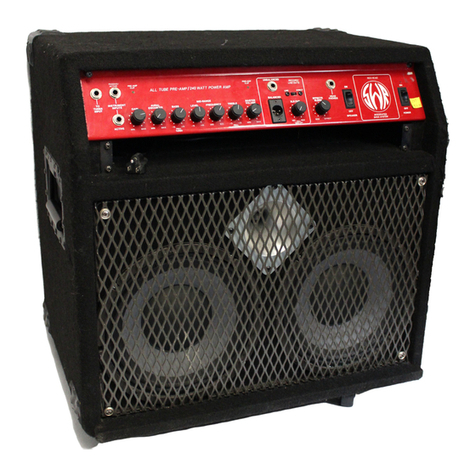
SWR
SWR Super Redhead User manual

SWR
SWR California Blonde II User manual
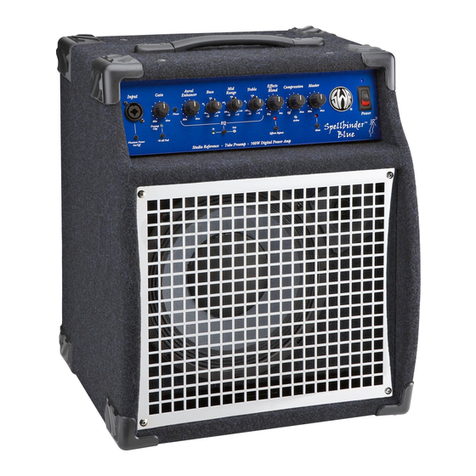
SWR
SWR Spellbinder Blue User manual
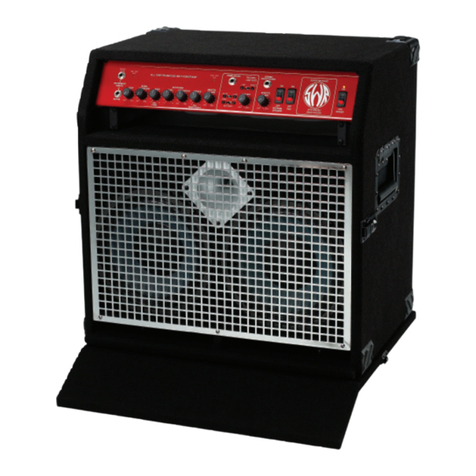
SWR
SWR Super Redhead User manual
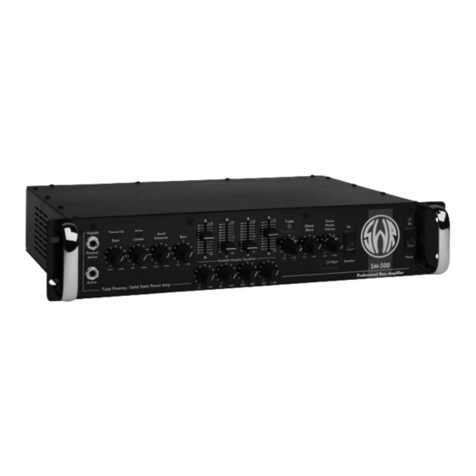
SWR
SWR SM-500 User manual
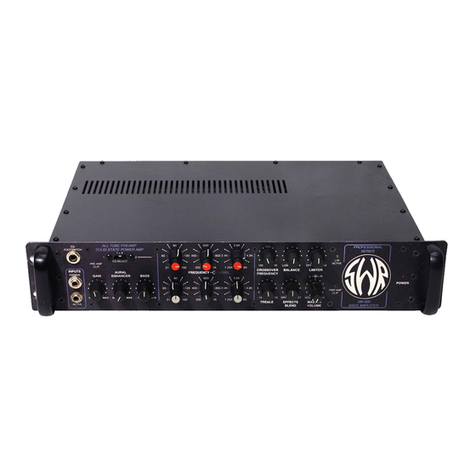
SWR
SWR SM-900 User manual

SWR
SWR SM-500 User manual

SWR
SWR California Blonde User manual
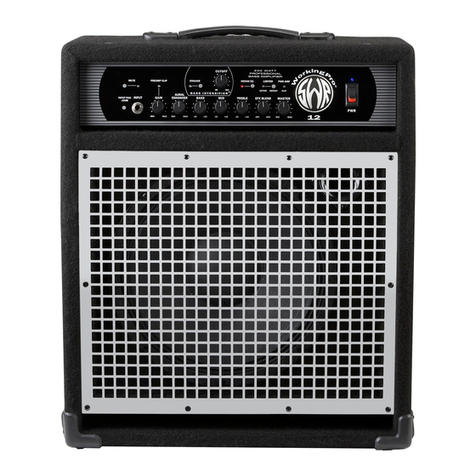
SWR
SWR WorkingPro WorkingPro 12 User manual

SWR
SWR WORKINGMAN'S 2004 User manual

SWR
SWR California Blonde User manual

SWR
SWR WorkingPro 12 User manual
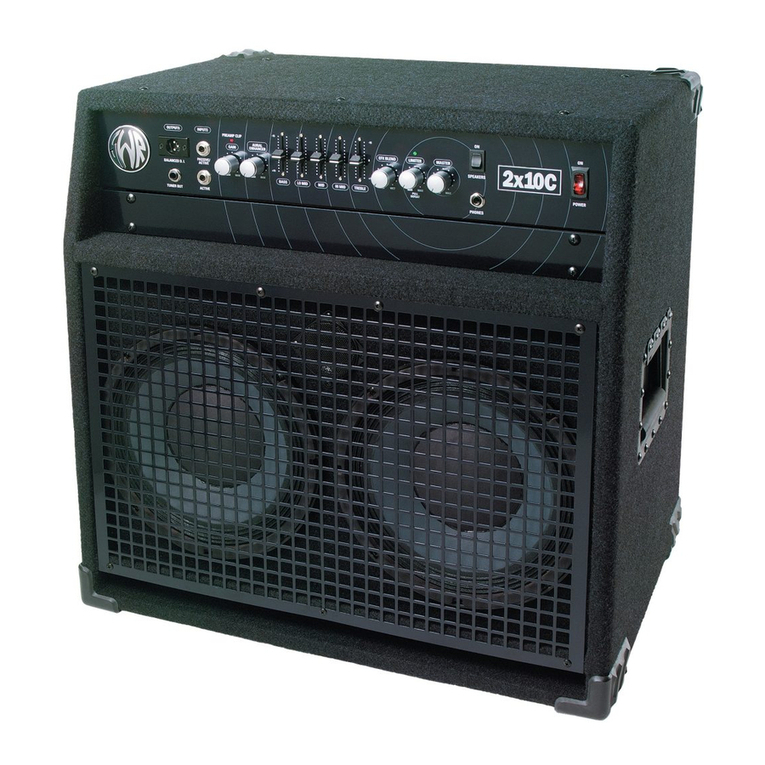
SWR
SWR WorkingPro 2x10C User manual

SWR
SWR Strawberry Blonde User manual

SWR
SWR BASS 750 User manual
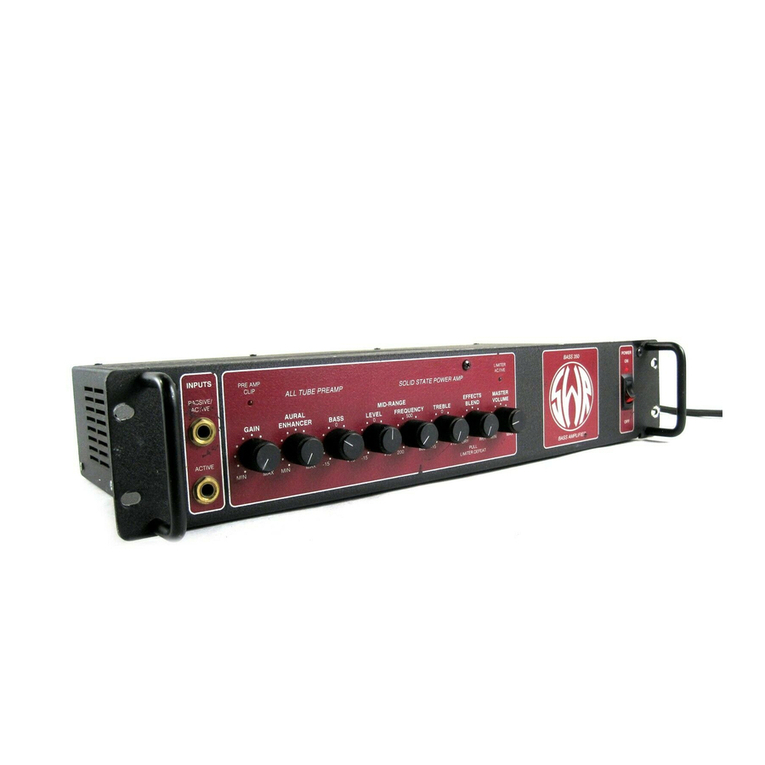
SWR
SWR BASS 350 User manual
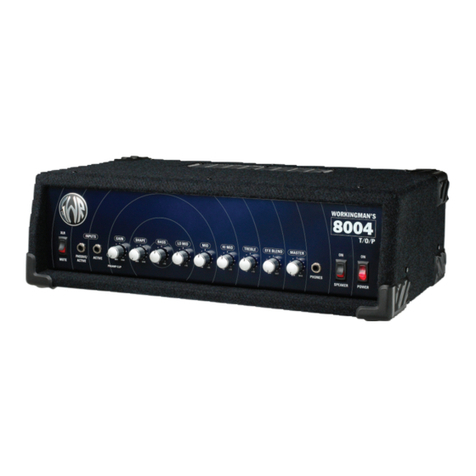
SWR
SWR Workingman's 8004 O User manual

SWR
SWR PB-200 User manual
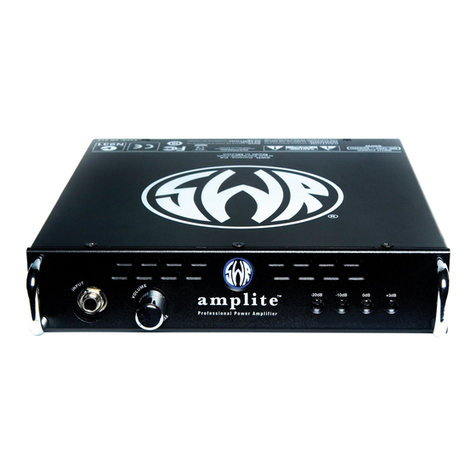
SWR
SWR amplite User manual

